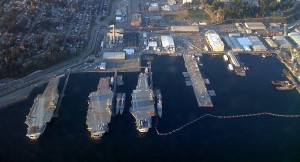The USS Enterprise’s decommissioning is already scheduled. The other carriers in the fleet were expected to be in service for at least another decade or so.
But a recent issue of Time Magazine says a lot of money could be saved by critically examining the Department of Defense’s budget. How to Save a Trillion Dollars advocates reducing the number of Aircraft carriers in the Navy’s fleet from 11 to 8.
On a damp, gray morning in late February, Navy admirals, U.S. Congress members and top officials of the nation’s biggest shipyard gathered in Norfolk, Va., to watch a computerized torch carve bevels into a slab of steel as thick as your fist.
The occasion: the ceremonial cutting of the first piece of a $15 billion aircraft carrier slated to weigh anchor in 2020. That ship — still unnamed — will follow the just-as-costly Gerald R. Ford, now 20% built and due to set sail in 2015.
Meanwhile, on the other side of the world, China is putting the final touches on a new class of DF-21 missiles expressly designed to sink the Ford and its sister ship as well as their 5,000-person crews. China’s missiles, which will likely cost about $10 million each, could keep the Navy’s carriers so far away from Taiwan that the short-range aircraft they bear would be useless in any conflict over the tiny island’s fate.
Aircraft carriers, born in the years before World War II, are increasingly obsolete platforms of war. They feature expensive manned aircraft in an age when budgets are being squeezed and less expensive drones are taking over. …
Even Defense Secretary Robert Gates warned last year of “the growing antiship capabilities of adversaries” before asking what in Navy circles had long been the unaskable question. “Do we really need 11 carrier strike groups for another 30 years when no other country has more than one?”
Last month the U.S. Naval Institute blog had a post about moving to smaller aircraft carriers: Must Every Carrier be a Supercarrier?
… But what really jumps out from Col Desens’ comments is the possibility that a smaller aircraft carrier with such a weapon as the F-35B could have efficacy as an alternative to the traditional supercarrier that has been the sole contestant in the US Navy’s aircraft carrier building arena since the commissioning of the Forrestals in the late 1950s. …
If the number of CVNs [nuclear aircraft carriers -JK] in commission shrinks to 9 or even 8 in the coming decade, which is a distinct possibility, we are left with a shortage of assets to cover a world-wide commitment. When the question is asked again, as it will be, “Where are the carriers?”, there are two answers that we should take great pains to avoid.
USS Enterprise is already scheduled to be retired, and I assume that the USS Gerald R. Ford will be completed. To reduce the fleet to 8 carriers would require sending 3 Nimitz-class aircraft carriers to an early retirement.
If the Navy was told to remove three more carriers from their fleet, I’d guess they’d start with the ones that have not yet undergone a Refueling and Complex Overhaul (cost: $2.4billion or so). This maintenance is performed about 25 years into the carrier’s life. The Theodore Roosevelt started its RCOH procedure in 2009, and the Abraham Lincoln is next in line.
What would could be done with three “surplus” nuclear carriers? The last of the oil-powered carriers were put into the reserve fleet, where ships are held for potential reactivation. The Independence, Constellation, and Ranger are tied to the docs at the Puget Sound Naval Shipyard:
Nuclear-powered ships can’t be treated this way, as the reactors require constant maintenance. The highly enriched uranium fuel is also rather problematic.
The professional navy people I’ve communicated with don’t like the idea of dedicating the USS Enterprise to disaster response. They give several reasons: it’s too old, it’s the only ship of its class, it’s a prototype that requires any number of unique parts ($$$), it was last refueled in 1990 and is now running low on atoms, etc.
If three Nimitz-class carriers were to be retired early, perhaps the politicians can order the Navy to tell them what would be involved in repurposing one or more of these ships.
